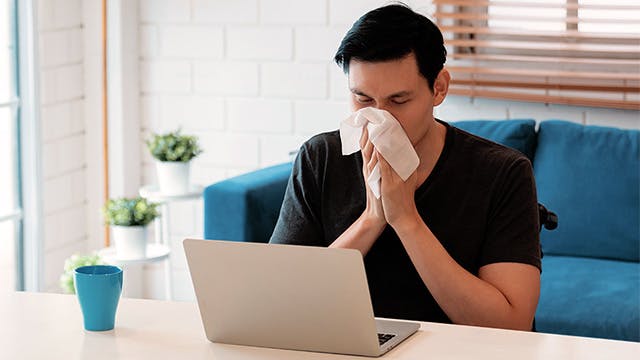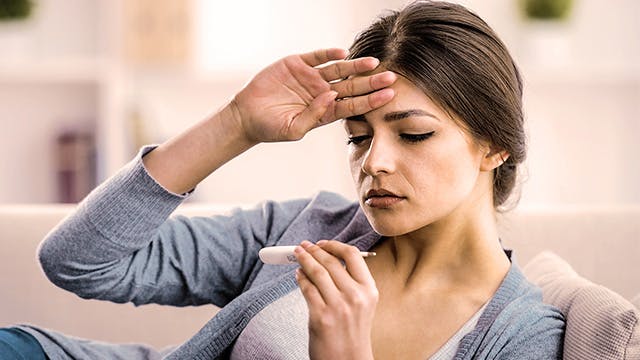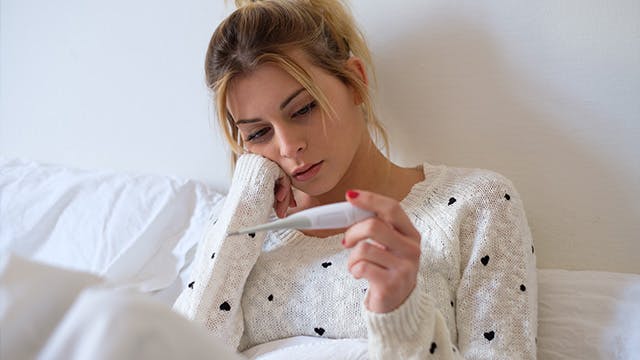What are the chills?
If you’ve ever had a high temperature, there’s a good chance you’ve also experienced that strange phenomenon of suddenly feeling very cold or shivery, even though your body is hot1. That feeling is known as ‘the chills’ and they are most commonly associated with fever (a temperature of above 103°F in adults), since chills often happen when the body is about to experience a rise in temperature1,2 and the shivering feeling caused by the chills is simply the result of rapid muscle contractions. These contractions are your body’s way of warming itself up when it’s feeling cold.1
Chills are more common in children than adults, since children are more likely to develop a higher fever than the average grown-up.1
What causes fever with chills?
Since chills are so directly linked with fever, they will most likely share the same cause. A low grade (slight) or high grade fever is your body’s natural response to a viral or bacterial infection. Your body tries to fight off the infection by stimulating your immune system, raising your temperature to help prevent any viruses or bacteria from thriving.3
Some common illnesses that may cause fever and chills include: 4
- colds or the flu,
- kidney or urinary tract infections (UTIs),
- bronchitis,
- strep throat,
- ear infections.
If you’re suffering with the flu, you may experience common symptoms such as fever, chills (often sudden fever and chills, since flu symptoms tend to come on very quickly), headaches, body aches and fatigue – as well as other respiratory symptoms.7
Learn more about what colds and the flu look like.
What causes chills but no fever?
There are a few reasons you might experience chills but not fever. Firstly, as mentioned above, chills can often predict a fever or an oncoming rise in the body’s temperature, so it’s possible that you will experience chills and no fever at first, before the fever actually comes on.1
Other potential causes of chills that are not related to fever or infection may include:
- Being too cold. Yes, it can be that simple. Since chills are the body’s way of trying to increase your temperature, shivering may merely be the result of a freezing winter’s night or being in a room that’s too cold. Your body could just be turning on its natural heating system.1
- Low blood sugar (hypoglycemia). This is most common in people who have diabetes. If blood sugar levels become too low it can cause shakiness, which often looks similar to the chills.5
- Panic attacks. Feelings of extreme anxiety can cause serious physical, as well as psychological, distress. Symptoms of a panic attack may include chills, sweats, chest pain, dizziness, heart palpitations and shortness of breath.5
- Night sweats and chills. Your body is constantly regulating its own temperature, even while you sleep. Most of us know the unpleasant feeling of waking up in the night either freezing cold or feeling so hot it’s as if the room is on fire; moving between chills and sweats. These are ‘night sweats’, and they may occur if your bedroom gets too hot at night, as your body tries to cool you down. The same goes when your bedroom is too cold; you may get the chills as your body shakes to try to get warm again.6
- Stomach flu (gastroenteritis). If you’re suffering from stomach pain and chills, there’s a good chance you have a stomach flu. Despite the name, gastroenteritis isn’t caused by the same virus as the regular flu, but by other types of viruses, bacteria or toxins. It can cause terrible stomach pain, diarrhea, nausea or vomiting, headaches and body aches – and of course, fever and chills.8
Treatment – relieving fever
Suffering through fever and its associated chills can be extremely unpleasant, and you may be wondering how to break a fever – or at least reduce it. Thankfully, most fevers will go away naturally within a few days, but there are some simple steps you can take in the meantime to help feel better:3, 9
- Try a fever-reducing medicine. An over-the-counter medicine like paracetamol or ibuprofen can help to reduce fever. Theraflu Multi-Symptom Severe Cold Hot Liquid Powder will help to both reduce fever and get to work on your worst cold and flu symptoms – including cough, headache, body aches, sore throat pain and congestion.
- Drink plenty of fluids. This will help to cool your body down and prevent dehydration.
- Get plenty of rest. Allow your body some time to recover and stay home from work or school.
- Take a lukewarm bath. Do not try to make yourself colder with a cool or cold bath. You can also apply damp washcloths with slightly warm water to your forehead for some relief.
- Dress lightly. Wear loose and comfortable clothing, even if you have chills.
It’s important to note that these treatment options are only recommended for fever in older children and adults. Seek immediate medical attention if your child is under 3 months old and has a fever of above 100.4°F, or if they are 3-6 months old and have a fever of above 102°F.10



